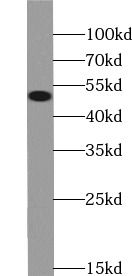Products
SIRT6 antibody
- SPECIFICATIONS
- CITATIONS
- Product Name
- SIRT6 antibody
- Catalogue No.
- FNab07884
- Size
- 100μg
- Form
- liquid
- Purification
- Immunogen affinity purified
- Purity
- ≥95% as determined by SDS-PAGE
- Clonality
- polyclonal
- Isotype
- IgG
- Storage
- PBS with 0.02% sodium azide and 50% glycerol pH 7.3, -20℃ for 12 months(Avoid repeated freeze / thaw cycles.)
Immunogen
- Immunogen
- sirtuin(silent mating type information regulation 2 homolog) 6
- Alternative Names
- SIR2 like protein 6 antibody, SIR2L6 antibody, SIRT6 antibody
- UniProt ID
- Q8N6T7
- Observed MW
- 49kd
Application
- Tested Applications
- ELISA, WB, IHC
- Recommended dilution
- WB: 1:200-1:2000; IHC: 1:50-1:200
Validated Images
 HeLa cells were subjected to SDS PAGE followed by western blot with FNab07884(SIRT6 antibody) at dilution of 1:400
HeLa cells were subjected to SDS PAGE followed by western blot with FNab07884(SIRT6 antibody) at dilution of 1:400
 Immunohistochemistry of paraffin-embedded human brain using FNab07884(SIRT6 antibody) at dilution of 1:50
Immunohistochemistry of paraffin-embedded human brain using FNab07884(SIRT6 antibody) at dilution of 1:50
- Background
- NAD-dependent protein deacetylase. Has deacetylase activity towards histone H3K9Ac and H3K56Ac. Modulates acetylation of histone H3 in telomeric chromatin during the S-phase of the cell cycle. Deacetylates histone H3K9Ac at NF-kappa-B target promoters and may down-regulate the expression of a subset of NF-kappa-B target genes. Acts as a corepressor of the transcription factor HIF1A to control the expression of multiple glycolytic genes to regulate glucose homeostasis. Required for genomic stability. Regulates the production of TNF protein. Has a role in the regulation of life span(By similarity). Deacetylation of nucleosomes interferes with RELA binding to target DNA. May be required for the association of WRN with telomeres during S-phase and for normal telomere maintenance. Required for genomic stability. Required for normal IGF1 serum levels and normal glucose homeostasis. Modulates cellular senescence and apoptosis. On DNA damage, promotes DNA end resection via deacetylation of RBBP8. Has very weak deacetylase activity and can bind NAD(+) in the absence of acetylated substrate.
IF: 5.396
- Journal:
- Food & Function
- Cited Date:
- 2021-08-27
- Product:



